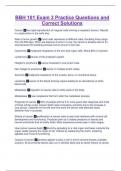BBH 101 Exam 3 Practice Questions and
Correct Solutions
Cancer ✅the rapid reproduction of irregular cells forming a neoplasm (tumor). Results
in a dysfunction in the cell's dna.
Rate of tumor growth ✅tumor cells reproduce at different rates. Doubling times range
from 23-209 days. When we discover a tumor or ump, the cancer is already well on it's
way because the doubling process occurs at such a low rate.
Carcinoma ✅malignant neoplasms of the skin and organ cells. About 85% of cancers
Lymphoma ✅cancer of the lymphatic system
Hodgkin's lymphoma ✅cancer localized in one lymph node
Non-hodgkin's lymphoma ✅cancer in multiple lymph nodes
Sarcoma ✅malignant neoplasms of the muscle, bone, or connective tissue
Leukemia ✅cancer of the blood-forming organs leading to an abundance of white
blood cells
Metastasis ✅migration of cancer cells to other parts of the body
Metastases ✅new neoplasms that form after the metastasis process.
Prognosis of cancer ✅50% of people will live 5 or more years after diagnosis and most
of these will be cured. Cancer death rates increasing, primarily due to the increase in
lung cancer. Depends on the site and how early the cancer was detected (early
detection key in success).
Effects of cancer ✅proliferation of cancer cells at each site interferes with normal cell
development and functioning. Produces pain as it creates pressure on tissues and
nerves and blocks flow of bodily fluids. Most experience severe pain in later stages.
How cancer causes death ✅direct by spreading to a vital organ and takes nutrients the
organ needs causing the organ to fail. Indirect by weakening the victim, impairing
appetite and immune functioning
Causes of cancer ✅genetics appear to play a role in some cancers (breast, prostate,
ovarian). Environmental factors also run in families (diet) and so family history of cancer
, does not necessarily mean that the cancer was due to genetics. In some cases you can
test your genes. The cause of cancer is an interplay between genetics and
environmental factors.
Cancer and ethnicity ✅anglo men- higher rates of bladder cancer
Hispanics- lowest rates of lung cancer but women have higher rates of cervical cancer
Blacks- highest rate of prostate cancer
Japanese- highest rate of stomach cancer
Chinese americans- lowest rates of liver cancer
Northern europeans- highest rates of breast cancer
Environmental factors of cancer ✅smoking (largest), diet, radiation, chemicals, viral
components of some cancers
Age, gender, and sociocultural factors of cancer ✅risk increases with age, especially
after middle age. Gender differences in types of cancer, breast cancer in women.
Blacks and whites have higher rates than other ethnic groups. Blacks are more likely to
die of cancer because it tends to get detected later, lack of access to health care. Low
es status, limited access to health care, stress, poor diet, low social support.
Diagnosis and treatment of cancer ✅physician tests for breast, colon, prostate, skin,
testes, cervix. Self-administered testing for some cancers like breast, skin, testes. Self
testing is the most important thing we can do.
Warning signs of cancer ✅change in bowel or bladder habits, a sore that doesn't heal,
unusual bleeding or discharge, thickening or lump in the breast or elsewhere,
indigestion or difficulty swallowing, obvious change in wart or mole, nagging cough or
hoarseness.
Diagnostic procedure of cancer ✅blood or urine tests for abnormal levels of hormones
or enzymes. Radiological imaging (xray, mri, ct scan) to look for tumors. Biopsy:
analysis of suspicious tissue.
Cancer treatments ✅options depend on size, site, and quality of life tissue. Age often
inappropriately affects treatment choice with those over 60 receiving less radiation and
chemotherapy. Surgery: can be removed if localized. Can remove large portions to
reduce symptoms. Healthy tissue can sometimes be removed in case of spreading.
Less tissue tends to be removed. Radiation: alters body cells so they are destroyed or
cannot reproduce. External beam therapy: beam of radiation directed to malignant
tissue. Internal radiation therapy: place radioactive substance inside body near tumor.
Microwave therapy (new). Causes troubling side effects since healthy tissue is affected
as well. Nausea, fatigue, burning, loss of appetite, sterility, digestive problems, reduced
bone marrow function. Anxiety.




